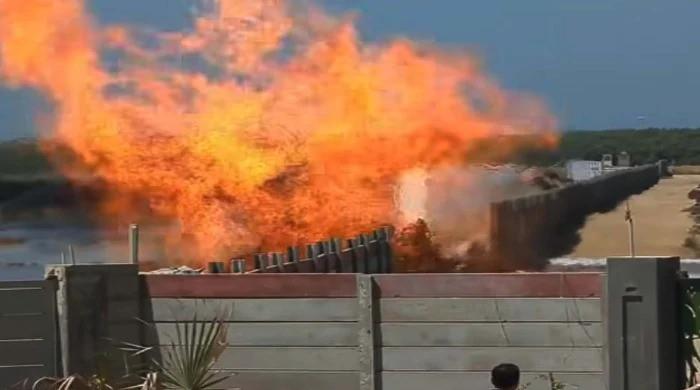Authorities are seeking assistance from a US-based firm to help extinguish the underground fire in Karachi’s Korangi Creek area, which is believed to have been caused by a natural gas pocket. Sources revealed this information to *Geo News*.
The Ministry of Energy (Petroleum Division) has established a technical committee to evaluate and contain the natural gas pocket that ignited the blaze. This fire has been burning for the past 12 days, raising concerns.
The committee includes Sikandar Ali Memon, Chief Operating Officer of Pakistan Petroleum Limited (PPL), along with Khurrum Shahzad, Chief Geologist from Oil and Gas Development Company Limited (OGDCL), Production Manager Habibullah Chohan, and Abdul Majid, General Manager of Pakistan Refinery Limited (PRL).
Sources indicate that the technical committee intends to procure two state-of-the-art gas detection metres. These metres will accurately measure the concentration of natural gas in the affected area. Experts are also considering filling the boreholes with cement as a fire containment strategy.
PRL has been instructed to immediately set up a camp office on its premises. All energy, petroleum, and service companies operating in Sindh have been asked to provide technical and logistical support for firefighting and remedial operations.
The fire’s flame, which was initially blue, has now turned reddish, indicating incomplete combustion and the emission of carbon monoxide. The fire started on March 29 after a 1,200-foot-deep bore was drilled at the site, raising concerns about the type and volume of gas involved.
A preliminary chemical analysis of water samples from the fire site revealed the presence of hazardous chemicals, according to PPL sources. The analysis detected excessive quantities of benzene, toluene, and tetrachloroethylene.
Tetrachloroethylene was measured at 33 microgrammes per litre, exceeding the standard limit of 5 mg. Benzene concentrations were recorded at 19 mg per litre, also surpassing the permissible threshold of 5 mg. Toluene was found at 15 microgrammes per litre, three times higher than the recommended safety level. A slightly elevated quantity of o-xylene was also detected.
The overall hydrocarbon content in the water was found to be within permissible limits, according to preliminary findings. Authorities are also investigating whether the chemicals are due to toxic waste being dumped via the Malir River and absorbed into the ground.
Specialised companies exist for handling such fires. As of now, it is unclear whether the authorities have contacted such a company or undertaken efforts to formulate a contingency plan or study to assess the extent of the gas reservoir.



Comments (0)
No comments yet. Be the first to comment!
Leave a Comment